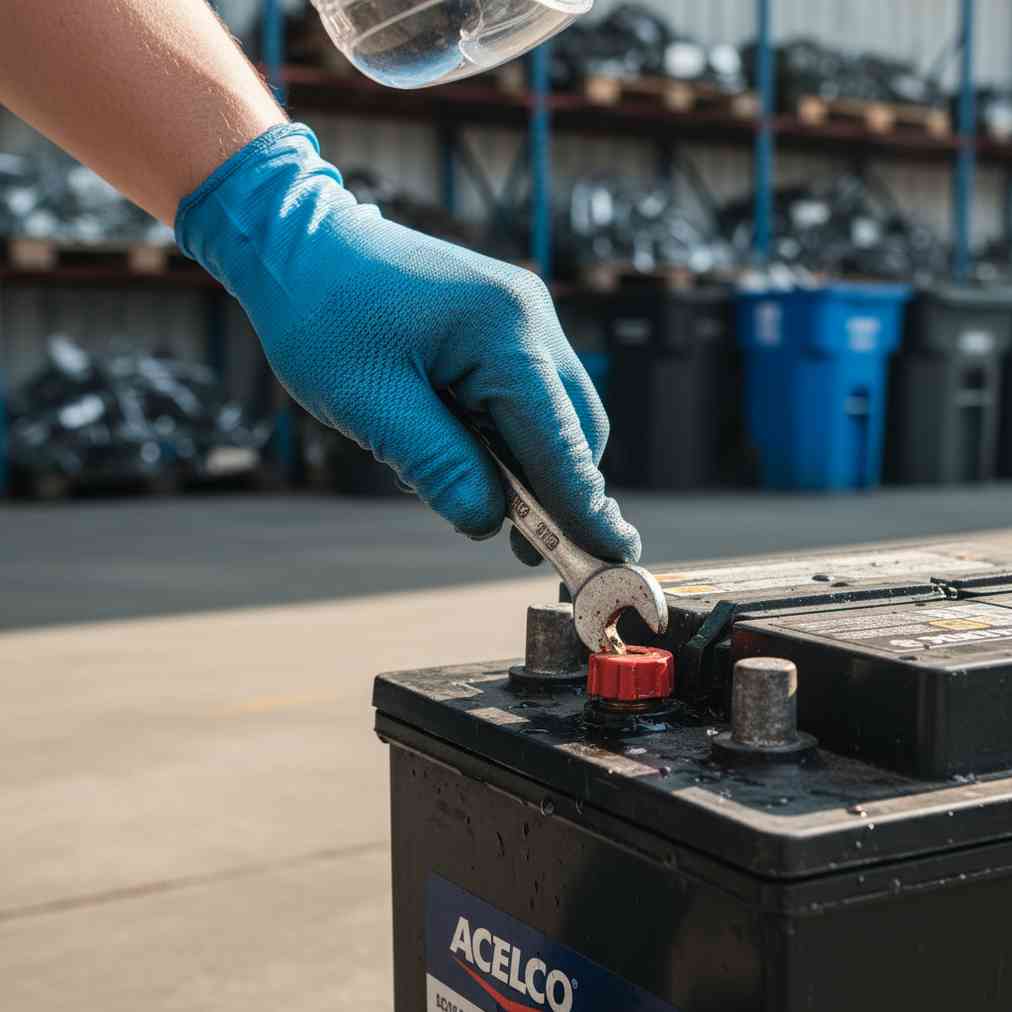Salvage car batteries contain valuable materials like lead and plastic that can be recycled for cash while protecting the environment. With proper safety precautions and the right knowledge, removing and recycling these batteries can provide both financial benefits and environmental responsibility. This comprehensive guide covers everything you need to know about safely handling salvage car batteries and turning them into cash.
Understanding Salvage Car Battery Value and Environmental Impact
Car batteries are among the most recycled products in America, with 98% of lead-acid batteries being recycled according to EPA estimates. The average car battery weighs around 40 pounds and contains valuable materials including lead, plastic casings, and sulfuric acid electrolyte.
“Your car battery is made of mostly recycled car batteries. The plastic case, the liquid electrolyte, even the lead metal itself all comes from old batteries.”
Unfortunately, approximately 1.8 million used car batteries are not responsibly recycled each year in the U.S., leading to environmental contamination. Lead is a commodity traded on worldwide markets, and its fluctuating price directly affects the scrap value of batteries.
Essential Safety Equipment and Preparation
Before attempting to remove any salvage car battery, proper safety preparation is crucial. Car batteries contain corrosive sulfuric acid and can produce flammable hydrogen gases, making safety equipment non-negotiable.
Required Personal Protective Equipment (PPE)
- Safety goggles – Splash-proof to protect eyes from acid
- Chemical-resistant gloves – Nitrile or rubber gloves rated for acid resistance
- Long sleeves and closed-toe shoes – Additional skin protection
- Apron or old clothing – Battery acid can permanently damage fabric
Essential Tools
- Wrench set (typically 10mm or 13mm – check vehicle manual)
- Wire brush or battery terminal cleaner
- Battery terminal puller (optional but helpful)
- Battery carrier or lifting strap
- Baking soda and water mixture for neutralizing acid spills
According to the Texas Department of Insurance safety guidelines, proper preparation is especially critical when working with electric or hybrid vehicle batteries, which operate at much higher voltages.
Step-by-Step Battery Removal Process
Following proper procedures ensures both safety and successful battery removal. The AAA Club Alliance guide emphasizes the importance of systematic approaches to battery disconnection.
Initial Vehicle Preparation
- Turn off the engine completely and remove keys from ignition
- Engage parking brake and ensure vehicle is in park (automatic) or gear (manual)
- Allow engine to cool if recently driven
- Work in well-ventilated area away from sparks or open flames
Locating and Accessing the Battery
Most car batteries are located under the hood, but some vehicles have batteries in the trunk or under seats. The Eric’s Car Care guide recommends consulting your owner’s manual if the battery location isn’t immediately obvious.
Once located, identify the battery terminals:
- Positive terminal (+) – Usually marked with red cable or cover
- Negative terminal (-) – Typically marked with black cable
Safe Disconnection Procedure
| Step | Action | Safety Note |
|---|---|---|
| 1 | Disconnect negative terminal first | Prevents short circuits and sparks |
| 2 | Loosen nut with wrench | Keep wrench from touching both terminals |
| 3 | Remove cable and secure away | Prevent accidental contact with battery |
| 4 | Repeat for positive terminal | Same precautions apply |
| 5 | Remove hold-down brackets | Keep hardware for potential reuse |
The Pedal Commander DIY guide emphasizes that always disconnecting the negative terminal first is crucial for preventing electrical shorts.
Physical Battery Removal
Car batteries are heavy and awkward to handle. Follow these lifting guidelines from the Home Depot battery replacement guide:
- Lift with proper form – Bend knees, not back
- Keep battery upright – Prevents acid spillage
- Use battery carrier if available – Reduces strain and improves grip
- Get assistance for heavy batteries – Some batteries exceed 60 pounds
Understanding proper battery removal techniques is essential whether you’re working on your own vehicle or sourcing parts from salvage yards.
Safety Hazards and Risk Mitigation
Working with salvage car batteries presents several serious safety risks that require careful attention and proper precautions.
Chemical Hazards
- Sulfuric acid – Can cause severe burns to skin and eyes
- Lead contamination – Toxic heavy metal requiring careful handling
- Hydrogen gas emission – Explosive when concentrated
- Corrosive terminals – Can damage tools and clothing
“Improper battery disposal comes with a wide-range of trouble and consequences. The chemicals inside them can have negative effects on our health, homes, ecosystems, and surrounding environment. Most damages caused by irresponsible car battery disposal take decades to reverse, if reversible at all.”
Electrical Safety Considerations
Standard 12-volt car batteries can deliver dangerous current levels, while hybrid and electric vehicle batteries operate at much higher voltages. The Michigan Environmental Guide for Salvage Owners provides specific protocols for handling different battery types safely.
- Use insulated tools to prevent electrical shorts
- Never allow metal objects to bridge battery terminals
- Keep fire extinguisher rated for electrical fires nearby
- Consult professionals for high-voltage EV batteries
Recycling Options That Pay Cash
Once you’ve safely removed salvage car batteries, several recycling options can provide cash compensation while ensuring environmental responsibility. The EPA’s End-of-Life Vehicle Processing guidelines outline proper recycling procedures that maximize both environmental benefits and economic returns.
Scrap Metal Recycling Centers
Local scrap yards represent the most accessible option for individual battery recyclers. These facilities typically pay cash based on current lead market prices and battery weight.
| Facility Type | Payment Method | Typical Price Range | Volume Requirements |
|---|---|---|---|
| Local Scrap Yards | Cash on delivery | $0.25-$0.45/lb | No minimum |
| Specialized Battery Recyclers | Check or wire transfer | $0.30-$0.50/lb | Often 1000+ lbs minimum |
| Auto Parts Stores | Store credit/core charge | $5-15 credit value | Individual batteries |
Specialized Battery Recycling Companies
Companies like Interstate Batteries operate large-scale recycling programs that may offer better pricing for bulk quantities. These specialized recyclers often provide:
- Competitive pricing based on market rates
- Pickup services for large volumes
- Proper documentation for environmental compliance
- Professional handling of hazardous materials
Auto Parts Stores and Core Charges
While auto parts stores like AutoZone and O’Reilly’s accept old batteries, they typically offer store credit rather than cash. This option works best when you need to purchase new parts or batteries.
If you’re looking to sell a junk car that includes a battery, consider removing the battery separately to maximize your overall return.
Maximizing Battery Recycling Value
Several factors influence the cash value you can receive for salvage car batteries. Understanding these variables helps maximize your recycling profits.
Factors Affecting Battery Value
- Lead market prices – Fluctuate daily based on commodity trading
- Battery weight – Heavier batteries contain more valuable lead
- Battery condition – Intact casings preferred over damaged units
- Local competition – More recyclers typically mean better prices
- Volume discounts – Bulk quantities often receive premium pricing
Timing Your Battery Sales
Lead prices fluctuate based on global market conditions. Monitoring commodity prices can help you time your battery sales for maximum profit. Consider storing batteries safely until prices improve, but ensure proper ventilation and containment to prevent environmental hazards.
Environmental Benefits of Battery Recycling
Recycling salvage car batteries provides significant environmental benefits beyond cash compensation. The closed-loop battery recycling system is remarkably efficient, reusing virtually all battery components.
Resource Conservation
- Lead recovery – 98% of battery lead is recyclable
- Plastic reuse – Battery cases become new battery housings
- Acid neutralization – Converted to sodium sulfate for industrial use
- Energy savings – Recycling uses 60% less energy than mining new lead
The environmental impact extends beyond material recovery. Proper battery recycling prevents soil and groundwater contamination that can persist for decades. The Ohio EPA Salvage Guide details the long-term environmental consequences of improper battery disposal.
Legal Requirements and Compliance
Many states have specific regulations governing battery disposal and recycling. Understanding these legal requirements protects you from potential fines and ensures responsible recycling practices.
Common State Regulations
- Landfill bans – Most states prohibit battery disposal in regular trash
- Retailer take-back programs – Many states require stores to accept old batteries
- Proper transportation – Regulations for moving batteries safely
- Documentation requirements – Some states require recycling records
Before recycling batteries, check your local and state regulations to ensure compliance with all applicable laws.
Transportation and Storage Safety
Safely transporting salvage car batteries requires proper preparation to prevent spills, damage, and potential hazards during transport to recycling facilities.
Safe Transportation Guidelines
- Keep batteries upright – Prevents acid spillage during transport
- Secure batteries firmly – Prevent sliding or tipping in vehicle
- Use appropriate containers – Acid-resistant trays or boxes
- Ensure ventilation – Allow hydrogen gas to dissipate safely
- Avoid extreme temperatures – Heat can increase gas production
Short-term Storage Considerations
If you need to store batteries before recycling, follow these safety protocols:
- Store in well-ventilated, dry areas
- Keep away from heat sources and open flames
- Use pallets to prevent ground contact
- Cover batteries to prevent rain exposure
- Inspect regularly for leaks or damage
Quality Assessment for Used Battery Buyers
When purchasing used batteries from salvage yards, understanding quality assessment helps ensure you get functional components. This knowledge is valuable whether you’re finding salvage yards near me or evaluating batteries for resale.
Visual Inspection Checklist
| Inspection Point | Good Condition | Avoid |
|---|---|---|
| Battery Case | Intact, no cracks | Cracked, bulging, or warped |
| Terminals | Minimal corrosion | Heavy corrosion or damage |
| Electrolyte Level | Adequate fluid visible | Dry cells or low fluid |
| Manufacturing Date | Less than 3-5 years old | Excessively old batteries |
Performance Testing
When possible, test battery voltage and performance before purchase:
- Voltage testing – Should read around 12.6 volts when fully charged
- Load testing – Professional equipment can assess battery capacity
- Specific gravity testing – Indicates electrolyte condition
- Cold cranking amp testing – Measures starting power capability
Economic Benefits of Used Auto Parts
The practice of recycling car batteries aligns with broader economic benefits of using salvaged automotive components. According to the AlexCar removal and replacement guide, understanding these benefits helps consumers make informed decisions about repairs and parts sourcing.
Cost-Effectiveness Analysis
- Immediate savings – Used batteries cost 50-70% less than new
- Reduced labor costs – Self-service yards offer additional savings
- Warranty options – Many salvage yards offer limited warranties
- Compatibility assurance – OEM parts ensure proper fitment
Environmental Sustainability Impact
Reusing automotive components, including batteries, provides significant environmental benefits:
- Reduces manufacturing energy consumption by up to 85%
- Decreases raw material extraction requirements
- Minimizes landfill waste accumulation
- Lowers carbon footprint of automotive repairs
Recent Industry Trends and Developments
The battery recycling industry continues evolving with new technologies, regulations, and market demands. Understanding these trends helps maximize recycling opportunities and stay compliant with changing requirements.
Regulatory Changes
- Stricter disposal regulations – More states implementing battery disposal bans
- Extended producer responsibility – Manufacturers taking greater recycling responsibility
- Transportation requirements – Enhanced safety protocols for battery transport
- Documentation standards – Improved tracking of battery lifecycle
Technology Improvements
Advancing recycling technologies are improving both efficiency and safety in battery processing:
- Automated disassembly systems reduce handling risks
- Advanced smelting techniques improve lead recovery rates
- Closed-loop processing minimizes environmental impact
- Real-time monitoring systems ensure safety compliance
Building a Successful Battery Recycling Operation
For those interested in scaling battery recycling activities, understanding the business aspects can help create sustainable and profitable operations.
Volume Sourcing Strategies
- Salvage yard partnerships – Establish relationships with local yards
- Auto repair shop connections – Collect batteries from service centers
- Fleet vehicle programs – Partner with commercial vehicle operations
- Individual collection routes – Develop systematic pickup schedules
Operational Considerations
| Aspect | Initial Investment | Ongoing Costs | Revenue Potential |
|---|---|---|---|
| Transportation | Vehicle/trailer purchase | Fuel, maintenance, insurance | Pickup service fees |
| Storage | Facility rental/purchase | Utilities, containment materials | Volume accumulation benefits |
| Safety Equipment | PPE, spill kits, ventilation | Equipment replacement | Compliance cost avoidance |
| Licensing | Permits, certifications | Renewal fees, inspections | Legal operation assurance |
Conclusion: Safe and Profitable Battery Recycling
Successfully removing and recycling salvage car batteries requires attention to safety, environmental responsibility, and market awareness. By following proper removal procedures, using appropriate safety equipment, and understanding recycling options, you can safely convert salvage batteries into cash while contributing to environmental protection.
The combination of high recycling rates, valuable material content, and growing environmental awareness makes battery recycling an increasingly important and profitable activity. Whether you’re removing a single battery from your own vehicle or developing a larger recycling operation, the principles outlined in this guide provide the foundation for safe, legal, and profitable battery recycling.
Remember that safety should always be the top priority when handling salvage car batteries. The hazardous materials involved require proper precautions, and the environmental benefits of recycling make the extra effort worthwhile. With proper knowledge and preparation, salvage car battery recycling can provide both financial returns and environmental benefits for years to come.





Leave a Reply
You must be logged in to post a comment.